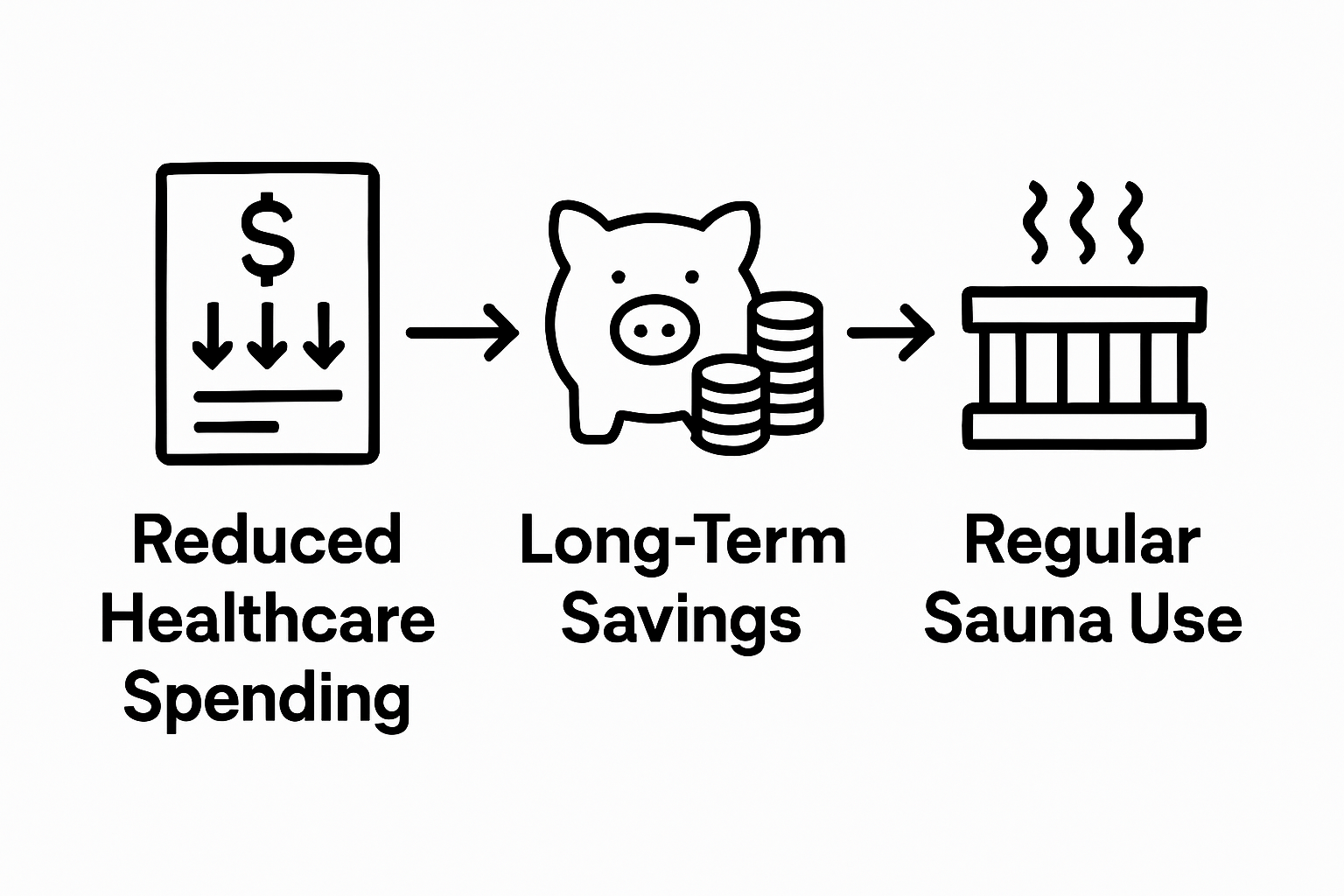
Understanding the Financial Benefits of Saunas
Saunas have been heating up relaxation routines for centuries. Across studies, people who use saunas regularly can see a drop in cardiovascular disease risk by up to 50 percent. Most folks think it’s all about a quick sweat and comfort but there is a surprising financial upside that stretches way beyond the steam.
Table of Contents
- What Are Saunas And How Do They Work?
- The Health Benefits Of Regular Sauna Use
- How Saunas Can Save You Money On Health Costs
- The Economic Value Of Home Saunas
- Comparing Investments: Saunas Vs. Other Wellness Solutions
Quick Summary
| Takeaway | Explanation |
|---|---|
| Saunas enhance cardiovascular health. | Regular sauna use can lower blood pressure and improve circulation, potentially reducing cardiovascular disease risk. |
| Saunas reduce stress and improve mood. | The heat in saunas promotes endorphin production, aiding in stress relief and better mental clarity. |
| Regular sauna use can lower healthcare costs. | Sauna sessions may reduce future medical expenses by lowering chronic disease risks and healthcare interventions. |
| Home saunas can increase property value. | Installing a sauna can enhance a home’s market appeal and value, making it a worthwhile investment. |
| Saunas offer long-term health benefits. | With minimal maintenance, saunas provide consistent health benefits over many years, supporting overall wellness. |
What Are Saunas and How Do They Work?
Saunas are specialized heated rooms designed to promote relaxation, wellness, and potential health benefits through controlled heat exposure. These therapeutic spaces have a rich history spanning centuries, originating in Finland and evolving into a global wellness practice that offers more than just temporary comfort.
The Basic Structure of Saunas
At their core, saunas are enclosed spaces constructed from heat-resistant materials like wood, typically cedar or pine, which can withstand high temperatures. According to research published by the National Institutes of Health, these rooms are heated to temperatures ranging between 70°C and 100°C (158°F to 212°F), creating an environment that triggers significant physiological responses.
The primary heating mechanisms in saunas can vary, but they generally fall into three main categories:
- Traditional Finnish Saunas: Use wood-burning or electric stoves with stones that radiate heat
- Infrared Saunas: Utilize electromagnetic radiation to directly warm body tissues
- Steam Saunas: Generate high humidity through water vapor, creating a wet heat environment
Physiological Responses and Health Mechanisms
When you enter a sauna, your body experiences a controlled heat stress that activates multiple biological processes. The elevated temperature causes your skin temperature to rise quickly, which triggers sweating and increases heart rate. This response is similar to moderate cardiovascular exercise, potentially offering metabolic and cardiovascular benefits.
The physiological changes during sauna use include:
- Increased blood circulation
- Enhanced metabolic rate
- Stimulation of the body’s natural cooling mechanisms
- Potential release of heat shock proteins that support cellular repair
These intricate bodily responses demonstrate why saunas are more than just a relaxation tool they represent a complex interaction between environmental heat and human physiology. While individual experiences may vary, the consistent exposure to controlled heat environments appears to offer potential wellness advantages that extend beyond immediate comfort.
The table below compares key features of the three main types of saunas discussed in the article to help clarify their differences and unique benefits.
| Sauna Type | Heating Method | Humidity Level | Typical Temperature Range |
|---|---|---|---|
| Traditional Finnish Sauna | Wood-burning or electric stove, stones | Low (dry heat) | 158°F - 212°F (70°C-100°C) |
| Infrared Sauna | Electromagnetic radiation (infrared panels) | Low (dry heat) | 120°F - 150°F (49°C-66°C) |
| Steam Sauna | Steam generator (water vapor) | High (wet heat) | 110°F - 120°F (43°C-49°C) |
The Health Benefits of Regular Sauna Use
Regular sauna use extends far beyond simple relaxation, offering a comprehensive range of potential health advantages that impact multiple bodily systems. From cardiovascular improvements to mental wellness, saunas represent a powerful tool for holistic health management.
Cardiovascular and Metabolic Advantages
According to research published in Mayo Clinic Proceedings, consistent sauna bathing demonstrates significant potential for reducing risks associated with cardiovascular diseases. The controlled heat exposure triggers a series of physiological responses that can positively influence heart health and metabolic functions.
Key cardiovascular benefits include:
- Reduced blood pressure
- Enhanced circulation
- Improved vascular function
- Potential reduction in arterial stiffness
Stress Reduction and Mental Wellness
Saunas serve as powerful stress management tools by activating the body’s natural relaxation mechanisms. The heat stimulates the production of endorphins, the body’s “feel good” hormones, while simultaneously lowering cortisol levels. This unique combination helps combat chronic stress and promotes mental clarity.
The mental health benefits encompass:
- Decreased anxiety symptoms
- Improved mood regulation
- Enhanced sleep quality
- Potential mitigation of depressive symptoms
Immune System and Recovery Support
Beyond immediate comfort, regular sauna sessions appear to bolster the body’s immune response and recovery processes. The controlled heat stress mimics fever conditions, potentially stimulating white blood cell production and enhancing the body’s natural defense mechanisms. Athletes and fitness enthusiasts often utilize saunas for muscle recovery and reduced inflammation, making them a valuable addition to comprehensive wellness strategies.
How Saunas Can Save You Money on Health Costs
Utilizing saunas strategically can offer significant financial benefits by potentially reducing long-term healthcare expenses and promoting preventative wellness. By understanding the economic advantages of regular sauna use, individuals can make informed decisions about their health and financial well-being.
Preventative Health Cost Reduction
According to research published in PubMed, regular sauna bathing is associated with reduced risks of multiple chronic health conditions. This proactive approach to wellness can translate into substantial healthcare cost savings by minimizing the likelihood of expensive medical treatments and interventions.
Potential areas of healthcare cost reduction include:
- Decreased cardiovascular disease treatment expenses
- Lower risk of chronic respiratory conditions
- Reduced medication costs for stress and mental health management
- Minimized physiotherapy and rehabilitation expenses
Long-Term Health Investment
Considering saunas as a preventative health investment reveals their potential economic advantages. The upfront cost of sauna installation or membership can be offset by the potential reduction in medical expenses over time. By supporting immune function, reducing stress, and improving overall physiological resilience, saunas offer a cost-effective approach to maintaining personal health.
Key economic benefits of regular sauna use encompass:
- Potential reduction in health insurance premiums

- Lower out-of-pocket medical expenses
- Decreased likelihood of extended medical treatments
- Enhanced productivity through improved health and wellness
Comprehensive Wellness Strategy
Beyond direct financial savings, saunas contribute to a holistic wellness strategy that can indirectly reduce economic burdens. Improved mental health, enhanced physical recovery, and stress management can lead to increased work performance, reduced sick days, and potentially higher earning potential. The cumulative effect of these benefits positions saunas as a smart, long-term investment in personal health and financial well-being.
The Economic Value of Home Saunas
Home saunas represent more than a luxury wellness feature they are strategic investments that can significantly enhance property value and personal lifestyle quality. Understanding their economic potential requires examining both immediate financial considerations and long-term benefits.
Installation and Initial Cost Analysis
According to Forbes research, the national average cost for a four-person steam sauna ranges approximately $4,500, with options spanning from $2,000 for smaller units to $10,000 for high-end infrared models. These initial investments can be strategically managed by considering several key factors:
- Location of installation (indoor vs outdoor)
- Size and type of sauna
- Complementary design with existing home architecture
- Potential energy efficiency features
Property Value Enhancement
Homeowners can potentially increase their property’s market value by incorporating a well-designed sauna. Strategic sauna placement and maintenance can contribute to a property’s appeal, with some markets seeing value increases between 5-15%. The sauna becomes not just a personal wellness tool but a distinctive feature that sets a property apart in competitive real estate markets.
Key property value considerations include:
- Attractiveness to wellness-focused buyers
- Unique selling point during home sales
- Potential return on investment ranging 50-70%
- Appeal to premium market segments
Long-Term Financial Considerations
Beyond immediate property value, home saunas offer ongoing economic advantages. The monthly operational costs typically range between $20-$50, making them a relatively affordable wellness investment. By promoting personal health, reducing potential medical expenses, and serving as a desirable home feature, saunas demonstrate substantial economic value that extends far beyond their initial purchase price.
Comparing Investments: Saunas vs. Other Wellness Solutions
Investing in personal wellness requires careful evaluation of different solutions, considering factors like initial cost, long-term benefits, maintenance expenses, and potential health outcomes. Saunas present a unique proposition when compared to alternative wellness investments.
Cost and Accessibility Comparison
According to research published in Mayo Clinic Proceedings, saunas offer comprehensive health benefits with relatively low ongoing expenses. When compared to other wellness solutions, they demonstrate significant economic advantages:
- Gym memberships: $50-$200 monthly
- Personal fitness equipment: $500-$5,000 upfront
- Sauna installations: $2,000-$10,000 one-time cost
- Alternative therapy sessions: $75-$250 per session
Health Impact and Efficiency
The health return on investment for saunas is particularly compelling. Unlike many wellness solutions that require consistent active participation, saunas provide therapeutic benefits through passive heat exposure. This unique characteristic makes them an efficient wellness strategy for individuals with limited time or physical constraints.
Key comparative health advantages include:
- Cardiovascular improvements similar to moderate exercise
- Stress reduction comparable to meditation practices
- Immune system support without additional time investment
- Potential chronic disease risk reduction
Maintenance and Longevity Considerations
When evaluating wellness investments, durability and maintenance costs are crucial. Saunas distinguish themselves through minimal ongoing expenses and long-term utility. A well-maintained home sauna can provide consistent health benefits for 10-20 years, making them a sustainable wellness solution. The combination of low operational costs, potential property value enhancement, and comprehensive health benefits positions saunas as a strategic investment in personal well-being.
This table summarizes the typical costs, benefits, and considerations for common wellness investments mentioned in the article to provide an at-a-glance comparison for readers.
| Wellness Solution | Typical Initial Cost | Ongoing/Monthly Cost | Primary Health Benefits | Maintenance/Longevity |
|---|---|---|---|---|
| Home Sauna | $2,000 - $10,000 (one-time) | $20 - $50 | Cardiovascular, stress relief | 10-20 years, minimal |
| Gym Membership | N/A | $50 - $200 | Fitness, overall wellness | Ongoing, varies |
| Personal Fitness Equipment | $500 - $5,000 (one-time) | Low (equipment upkeep) | Exercise, muscle building | 5-15 years, moderate |
| Alternative Therapy Sessions | N/A | $75 - $250 per session | Stress reduction, recovery | Per session |

Ready to Turn Health Savings Into Daily Wellness?
If you have ever wondered how regular sauna use can help trim down your future healthcare bills while making you feel your best now, you are not alone. The article above highlights important goals like lowering medical costs, reducing stress, and investing in long-term well-being. At Best Life Sauna, you can transform what you learned about the financial and health benefits of regular sauna use into real, lasting value for your home and your lifestyle.

Discover our full line of premium saunas and wellness solutions designed to deliver the cardiovascular, stress relief, and recovery benefits discussed in the article. Shop today and take advantage of promotional offers like free shipping on orders over $200. See how our customer reviews and price match guarantee put real savings and satisfaction within reach. Visit Best Life Sauna now to get started on the path to improved wellness and smarter spending. The sooner you act, the faster you can feel and see the benefits in your life and your wallet.
Frequently Asked Questions
What are the financial benefits of using a sauna?
Utilizing a sauna can lead to reduced healthcare costs by minimizing the risk of chronic health conditions, potentially lowering medical expenses, and enhancing overall well-being.
How can regular sauna use impact my health insurance costs?
Regular sauna use may contribute to better health, which could lead to lower health insurance premiums as it reduces the risk of chronic diseases and associated medical treatments.
Are home saunas a good investment for property value?
Yes, home saunas can enhance property value, with well-designed installations often increasing market appeal and property value by 5-15%, attracting wellness-focused buyers.
How do the ongoing costs of sauna ownership compare to other wellness solutions?
The monthly operational costs of a home sauna typically range from $20-$50, making it a cost-effective wellness investment compared to gym memberships or therapy sessions, which can be significantly higher.

